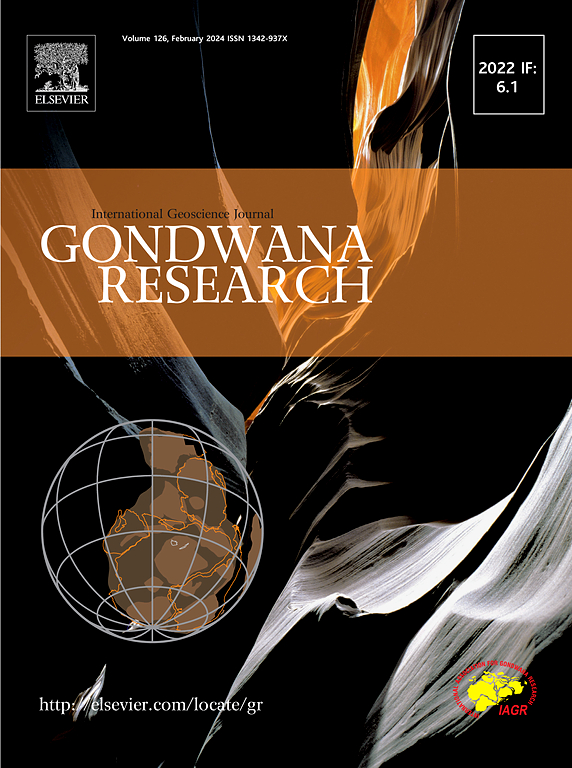Differential lithospheric evolution during craton destruction: Insights from Mesozoic mafic magmatic suites with transitional features in the North China Craton
IF 7.2
1区 地球科学
Q1 GEOSCIENCES, MULTIDISCIPLINARY
引用次数: 0
Abstract
During the Mesozoic, the North China Craton (NCC) especially the eastern part underwent significant destruction of its cratonic roots. During ∼125–120 Ma, the source of magmatism shifted from an ancient enriched lithospheric mantle to a juvenile depleted asthenospheric mantle. While this geochemical change is clear in the eastern NCC, it is unclear whether a similar shift occurred in the central NCC or if the lithospheric evolution differed across the craton. Mafic magmatic suites are key to understanding the evolution of cratonic lithospheric mantle, especially by analyzing their geochemical and isotopic transitions. This study examines the Mesozoic Laiyuan ultramafic–mafic intrusions in central NCC, classified into gabbro, gabbroic diorite, and cumulate suites (pyroxenite and hornblendite). Zircon U-Pb dating indicates gabbroic rocks formed between 136–124 Ma and cumulated between 130–129 Ma. These rocks also display similar isotopic signatures, including zircon Hf isotopes ranging from −24.9 to −7.8 and −28.3 to −15.9, (87Sr/86Sr)i ratios from 0.705945 to 0.706335 and 0.705692 to 0.706038, and εNd(t) values from −16.1 to −12.8 and −15.8 to −12.5, respectively. Geochemical and isotopic data suggest an enriched lithospheric mantle source influenced by subduction-related metasomatism with minimal crustal contamination. The gabbroic and ultramafic layers represent residual melts and cumulates from a common source, respectively. Geochemical data reveal a transition in the mantle source from ultramafic-mafic intrusions (∼140–124 Ma) to dolerite (∼125–117 Ma) and lamprophyre (∼115–110 Ma), indicating lithospheric thinning and asthenosphere upwelling. This gradual transition in the central NCC contrasts with the rapid change in the eastern NCC, reflecting different lithospheric evolution processes: thermo-mechanical erosion in the central NCC and lithospheric delamination in the eastern NCC. These findings highlight diverse mechanisms of cratonic destruction across the NCC.

克拉通破坏过程中岩石圈差异演化:华北克拉通中生代基性岩浆套过渡性特征
在中生代,华北克拉通特别是东部克拉通的克拉通根遭受了严重的破坏。在~ 125 ~ 120 Ma期间,岩浆活动的来源从一个古老的富岩石圈地幔转移到一个年轻的贫软流圈地幔。虽然这种地球化学变化在北克拉通东部很明显,但在北克拉通中部是否发生了类似的变化,或者在克拉通中岩石圈的演化是否有所不同,目前还不清楚。基性岩浆套是认识克拉通岩石圈地幔演化的关键,特别是分析其地球化学和同位素转变。本文研究了北中部莱源中生代超镁基性侵入岩,分为辉长岩、辉长闪长岩和辉长岩、角闪岩三种。锆石U-Pb测年表明辉长岩形成时间为136 ~ 124 Ma,堆积时间为130 ~ 129 Ma。锆石Hf同位素范围为−24.9 ~−7.8和−28.3 ~−15.9,(87Sr/86Sr)i比值为0.705945 ~ 0.706335和0.705692 ~ 0.706038,εNd(t)值分别为−16.1 ~−12.8和−15.8 ~−12.5。地球化学和同位素数据表明,该岩石圈地幔源受俯冲相关交代作用的影响,地壳污染最小。辉长岩层和超镁铁质层分别代表来自同一来源的残余熔体和堆积物。地球化学数据显示,地幔源由超镁铁质-基性侵入体(~ 140 ~ 124 Ma)向白云岩(~ 125 ~ 117 Ma)和煌斑岩(~ 115 ~ 110 Ma)转变,表明岩石圈变薄和软流圈上升流。北中陆块的这种逐渐转变与东陆陆块的快速变化形成对比,反映了不同的岩石圈演化过程:北中陆块的热机械侵蚀和东陆陆块的岩石圈剥离。这些发现强调了横跨NCC的克拉通破坏的不同机制。
本文章由计算机程序翻译,如有差异,请以英文原文为准。
求助全文
约1分钟内获得全文
求助全文
来源期刊

Gondwana Research
地学-地球科学综合
CiteScore
12.90
自引率
6.60%
发文量
298
审稿时长
65 days
期刊介绍:
Gondwana Research (GR) is an International Journal aimed to promote high quality research publications on all topics related to solid Earth, particularly with reference to the origin and evolution of continents, continental assemblies and their resources. GR is an "all earth science" journal with no restrictions on geological time, terrane or theme and covers a wide spectrum of topics in geosciences such as geology, geomorphology, palaeontology, structure, petrology, geochemistry, stable isotopes, geochronology, economic geology, exploration geology, engineering geology, geophysics, and environmental geology among other themes, and provides an appropriate forum to integrate studies from different disciplines and different terrains. In addition to regular articles and thematic issues, the journal invites high profile state-of-the-art reviews on thrust area topics for its column, ''GR FOCUS''. Focus articles include short biographies and photographs of the authors. Short articles (within ten printed pages) for rapid publication reporting important discoveries or innovative models of global interest will be considered under the category ''GR LETTERS''.
 求助内容:
求助内容: 应助结果提醒方式:
应助结果提醒方式:


